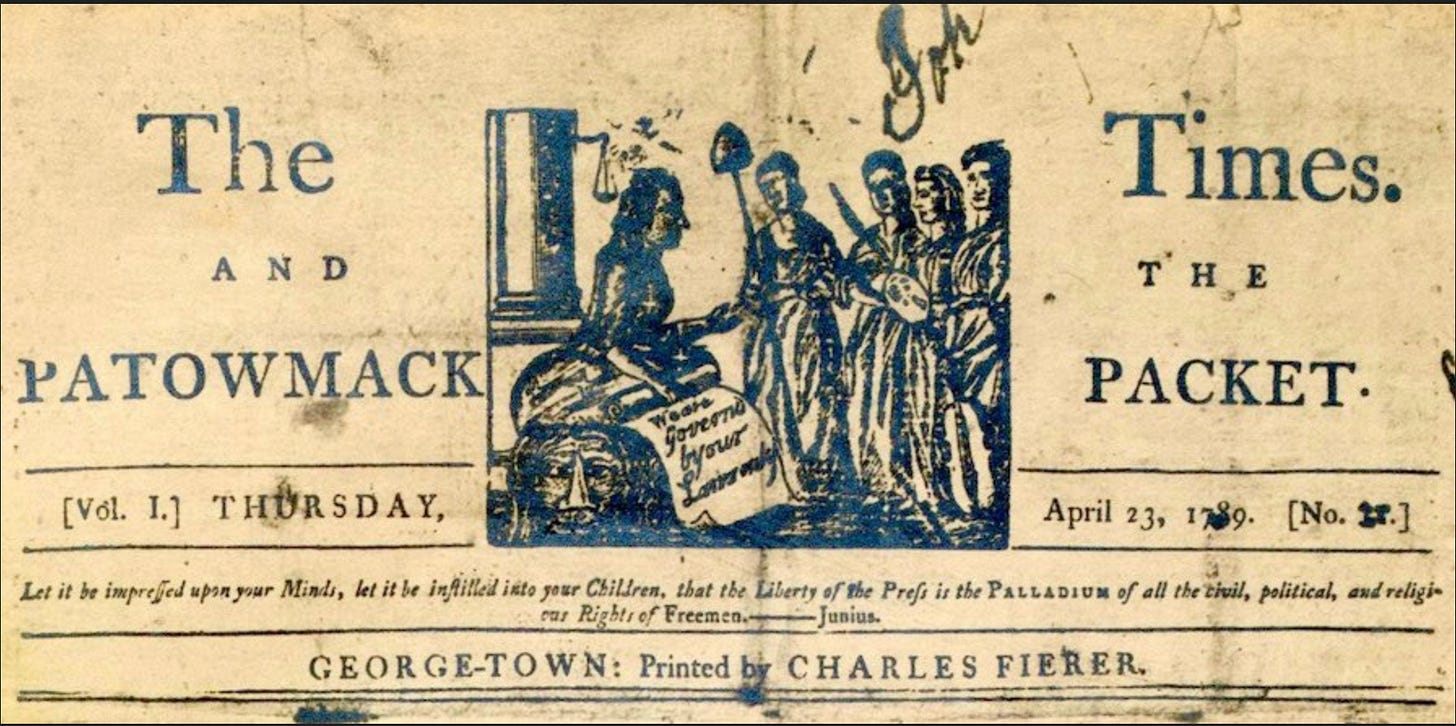Being analog in a digital world has its upsides, but no shortage of downsides. It’s probably fairly foolhardy to jump into the Substack space with no idea how it works, no media profile, and no plan to “create synergies,” as I believe they say. It’s also pretty daunting to see those expert in Substackery, and how they constantly put out new material and ensure that it’s all widely distributed into cyberspace.
All that is to say that I’m grateful for all the readers who have signed up (or, for some, been signed up…) for the The Patowmack Packet since I started in March. I’ve tried not to post pieces that one could read on other sites, or which were too easy, low-hanging fruit. Not to claim I’m always successful at quality over quantity, but I hope the articles have been worthwhile of your time and that they open up some new vistas for you. I should also admit that there have been some articles I tried first to get into established media sites, in part to help attract new subscribers to the Packet, and then put up here in revised form, which I hope doesn’t violate the spirit of Substack. One such piece I had hoped to have up before the end of December, on how, 100 years ago this year, the Library of Congress made the Declaration of Independence a “people’s document,” will appear soon after the New Year.
The Patowmack Packet remains a niche site, primarily focused on the National Capital Region (DC-VA-MD) and in particular its history. I’m fully aware it’s also an idiosyncratic site, not aimed at some sort of comprehensive coverage of either DC or history, but rather publishing articles on events, places, and issues that interest me or about which I’m learning. It’s history, guidebook, and current events planner rolled into one. That may prevent it from attracting a hundred thousand subscribers, but I’m happy to be in a conversation with a community that shares similar interests.
I’d say some of the highlights, at least for me, were an early article on the Washington area’s geology and a two-part series on the Potomac, as well as a four-part series on urban planning and the National Capital Planning Commission (trust me, it’s more interesting than it sounds—ever wonder why Washington is so beautiful? This series will give you a lot of the answers). But, each piece had a raison d’etre, so I hope you take a look at all of them, if you haven’t already.
So what’s ahead for the Patowmack Packet? I hope soon to be able to share with you news about my next big project, but suffice it to say that as we head into 2025, the Packet is likely to be focused even more on history, and maybe not only history geographically bounded by the D.C. region. After all, next year begins in earnest the countdown to America 250, our semiquincentennial anniversary. And, as I noted in my recent DC250 article, while Washington did not even exist in 1776, it will by rights be at the center of the multi-year celebration.
Keep an eye out for America/DC250-related pieces in the coming months. April marks the outbreak of the War for Independence, and I’ll have an article on a D.C. treasure, the American Revolution Institute, and its plans to commemmorate the Revolutionary War through 2033. I’ve already mentioned the VA250 Commission several times, and you’ll soon see a piece on this impressively active and wide-ranging organization. Back in July, I wrote an article on the anniversary of the Fairfax Resolves, and I’m planning a post on Gunston Hall, another D.C. treasure, home of George Mason, author of the Fairfax Resolves. Of course, when I call Gunston Hall, located in Lorton, Virginia, a “D.C. treasure,” I’m taking some geographic liberty, as I did when discussing Mount Vernon and the George Washington Presidential Library. But, liberty is what America’s all about, right? I take it readers will understand I mean treasures in the larger D.C. region, basically anything you can get to and back from by car in one day, with kids and D.C. area traffic. I guess it’s synecdochal tourism.
I’m also considering more structured interviews with some of the people running DC’s public spaces, institutions, and organizations. I know Substack has videos and/or podcasts, so that might be an option, as well. Suggestions for people to interview, places to write about, or events to highlight are always welcome, as well as your thoughts about more multimedia approaches. Since it’s a one-man show at the Patowmack Packet (as it was when Charles Fierer started the paper, back in 1789!), it’ll all be experimental and charmingly amateurish in execution.
So, before signing off for 2024, another thank you for being part of the Patowmack Packet. I look forward to continuing the conversation next year and hope you’ll be part of it, along with lots of new readers. A Happy New Year, to all.



Michael--I'd be happy to help/collaborate. This is an charming and interesting website.